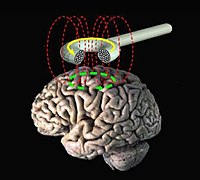
Photo from wikipedia
ABSTRACT Introduction: Neuromodulation techniques play an increasing role in the treatment of primary headaches. While initially reserved for refractory cases they are now increasingly taken into consideration in earlier treatment… Click to show full abstract
ABSTRACT Introduction: Neuromodulation techniques play an increasing role in the treatment of primary headaches. While initially reserved for refractory cases they are now increasingly taken into consideration in earlier treatment phases and in non-refractory situations. One of the main reasons for this paradigm shift is that most neuromodulation techniques are better tolerated as compared to the majority of pharmacological approaches. However, these techniques have their limitations that should be considered. Areas covered: The review provides an overview of the available techniques and their therapeutic rationale as well as on the evidence for their efficacy and their limitations. The review covers these aspects for non-invasive vagal nerve stimulation, sphenopalatine ganglion stimulation, external trigeminal nerve stimulation, occipital nerve stimulation as well as single-pulse and repetitive-pulse transcranial magnetic stimulation. Expert commentary: Most of the evidence is based on open-label studies. Sham devices used in controlled studies remain problematic as they either do not produce the paresthesias perceived during stimulation or induce some degree of stimulation. Invasive techniques require a surgical intervention with all the potential complications that may arise. In summary, some of the techniques provide an effective expansion of available treatment options but their indication should be thoroughly evaluated before treatment is considered.
Journal Title: Expert Review of Neurotherapeutics
Year Published: 2019
Link to full text (if available)
Share on Social Media: Sign Up to like & get
recommendations!